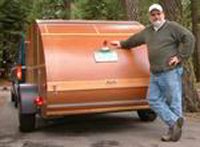jdaan wrote:I have the same reservations about welding directly to a Dexter axle, based on what I've read here. One way around that would be to have a 2x2 tube x-member and axle stubs welded to it, although apparently that's a bit complicated to get lined up properly. Here's a revised single tongue drawing with a 2x3x1/8 tongue mounted "sideways" and a 2x3 x-member. The weight on that without the axle is around 83 lb. Next to it is the simple a-frame design weighing in at 71 lb.
Does it make more sense to use the 2x3 cross-member for the forward one?
Justin
I like the A-frame... and I think that's been hashed through a few times.
If the tongue is straight, extending it to the axle tube instead of a regular frame crossmember makes sense with a suspension having such a fixed tube; the U-Haul rental travel trailers were built this way.
The U-Hauls had brackets welded to the axle tube, which leads to one of two possibilities:
- the welding right at the centre is far enough away from the rubber that it is not a problem; or,
the bracket was welded to the tube before the axle was assembled.
In any case, an entirely bolt-on bracket (welded to the tongue, bolted to clamp around the axle tube), seems like a practical approach.
As for the laid-flat 2x3... this make some sense to me. The SAE standard for hitches (J684) specifies the same required strength laterally and vertically: 50% of the full trailer weight. Since the tongue weight is typically only about 10% of the trailer weight, perhaps they didn't feel it was necessary to get more specific than that. Weakness - the tendency to break - is bad, but softness - the tendency to bend like a spring - is not so bad. Perhaps vertical softness (which would allow some pitching) might even be more tolerable than lateral softness (which would allow some yaw, or sway), so a big strong rectangular pole tongue might be better laid flat, instead of bracing it.
I still think that the A-frame is structurally much better, and preferable unless severe turning angles are desired.







